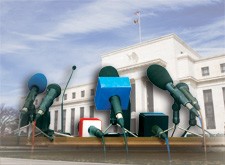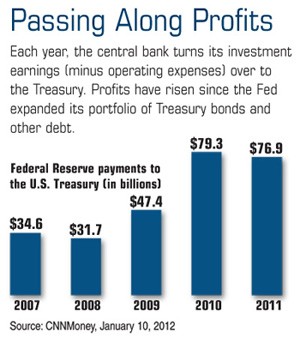Following the Federal Reserve
 To spur borrowing and boost the economy, the Federal Reserve cut the federal funds target rate to near zero at the end of 2008. More recently, the Fed disclosed that it is unlikely to raise rates until late 2014. In January 2012, the central bank released detailed forecasts for the federal funds rate — and stated a specific goal for the rate of inflation (2%) — for the first time in its history.1–2
To spur borrowing and boost the economy, the Federal Reserve cut the federal funds target rate to near zero at the end of 2008. More recently, the Fed disclosed that it is unlikely to raise rates until late 2014. In January 2012, the central bank released detailed forecasts for the federal funds rate — and stated a specific goal for the rate of inflation (2%) — for the first time in its history.1–2
The Federal Reserve and the Federal Open Market Committee (FOMC) operate under a dual mandate to conduct monetary policies that foster maximum employment and price stability. In response to the financial crisis, lingering economic weakness, and high unemployment, the Fed has taken a series of unconventional steps.
Meet the Committee
The FOMC meets eight times a year. Projections for economic growth, unemployment, and inflation are collected from all seven members of the Board of Governors of the Federal Reserve System (including Chairman Ben Bernanke) and 12 regional Reserve Bank presidents ahead of scheduled FOMC meetings.
Behind closed doors, participants discuss how economic conditions are likely to change and which policy responses might be appropriate given the economic outlook. The 12 committee members — including all seven governors, the president of the Federal Reserve Bank of New York, and four of the remaining 11 Reserve Bank presidents (on a rotating basis) — vote on specific policy actions proposed during the meeting. Quarterly projections are typically released after their two-day meetings.
 Portfolio Moves
Portfolio Moves
During the 2008 credit crisis, the Fed helped stabilize the banking system by making emergency loans to banks and businesses and buying up “toxic” securities whose values had plummeted. The central bank was criticized by some people for putting itself in a position to sustain losses, but so far Fed holdings have generated profits.3
The central bank now holds almost $2.9 trillion of Treasuries, agency debt, and other securities, much of which was acquired through bond-buying programs known as quantitative easing and QE2.4
In September 2011, the Fed announced a plan to help drive down long-term rates further. “Operation Twist” involved trading $400 billion of short-term Treasuries for new ones with longer maturities. If the economy falters in 2012, a third round of monetary stimulus remains a possibility.5
Communication Matters
One of the most powerful tools the Fed has at its disposal is communication. Traditionally, speeches made by FOMC participants, published economic projections, and the official statements released after each FOMC meeting have been used to inform the public.
Chairman Bernanke began holding press conferences after FOMC meetings in 2011, and detailed rate forecasts followed in January 2012.6 This marks quite a shift from the early 1990s, when the Fed didn’t even announce when (or by how much) rates had been adjusted.7
Bernanke believes that greater transparency and the clarity gained from forecasts could push down long-term rates and help shape the expectations and behavior of investors, businesses, and households — and managing the public’s expectations could make the Fed’s policy moves more effective.8
Investors should remember that future Fed actions will depend on economic conditions. If inflation rises more than expected, higher interest rates will likely follow, despite any previous forecasts.
All investments are subject to market fluctuation, risk, and loss of principal. When sold, investments may be worth more or less than their original cost. U.S. Treasury securities are guaranteed by the federal government as to the timely payment of principal and interest.
1) Federal Reserve, 2012
2, 6) CNNMoney, January 25, 2012
3) The Wall Street Journal, January 10, 2012
4) CNNMoney, January 10, 2012
5) The Wall Street Journal, September 21, 2011
7–8) The Wall Street Journal, January 4, 2012
The information in this article is not intended as tax or legal advice, and it may not be relied on for the purpose of avoiding any federal tax penalties. You are encouraged to seek tax or legal advice from an independent professional advisor. The content is derived from sources believed to be accurate. Neither the information presented nor any opinion expressed constitutes a solicitation for the purchase or sale of any security. This material was written and prepared by Emerald. Copyright © 2012 Emerald Connect, Inc.

